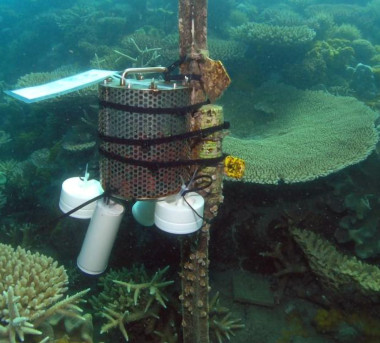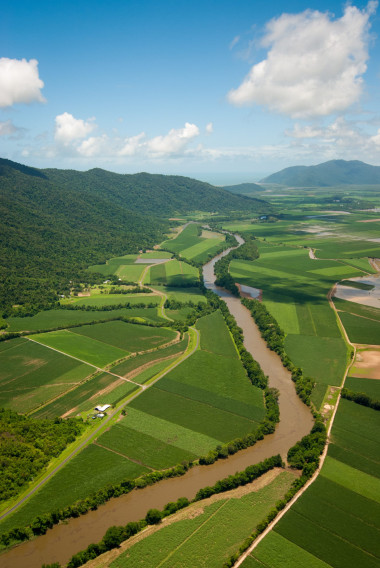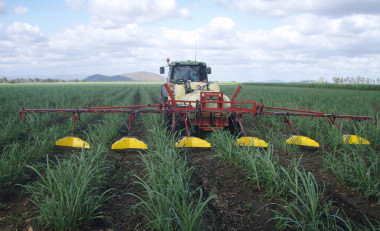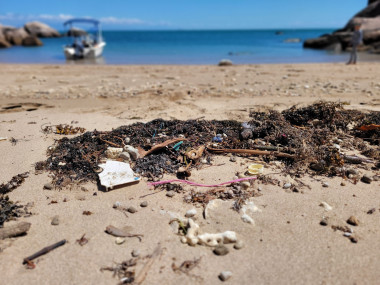Pesticides are used to protect crops and vegetated areas from pest organisms (e.g., weeds, insects and fungal disease). Pesticides have been detected in sediments and waters of rivers, creeks, wetlands, estuaries, and the inshore parts of the Great Barrier Reef. The types and concentrations of pesticides in fresh, estuarine and marine ecosystems vary between catchments and regions, reflecting the main land uses in each area. Pesticides have been reported to affect a range of marine organisms including corals, microalgae, crustose coralline algae and seagrass, with increasing evidence of their impacts on freshwater, wetland and estuarine ecosystems. The Reef 2050 Water Quality Improvement Plan pesticide target is to protect at least 99% of aquatic species at end-of-catchments by 2025. Other pollutants that may affect the Great Barrier Reef and are covered in the 2022 Scientific Consensus Statement include metals, plastics, persistent organic pollutants, per- and poly-fluoroalkyl substances, personal health care products, coal, and sunscreens.
Scope
The diagram below shows the scope of the pesticides and other pollutants theme. It represents the Great Barrier Reef catchment and marine environment and shows the ecological impacts of pesticides and other pollutants on aquatic ecosystems and biota including the influence of flood plumes which mostly affect inshore and midshelf areas. The primary sources are shown, of which agriculture is the main contributor for pesticides, with industry, urban and other uses among the key sources for other pollutants. Transport pathways are also shown, including surface and subsurface runoff and groundwater movement. Examples of potential management practices to minimise pesticide risk are also synthesised.
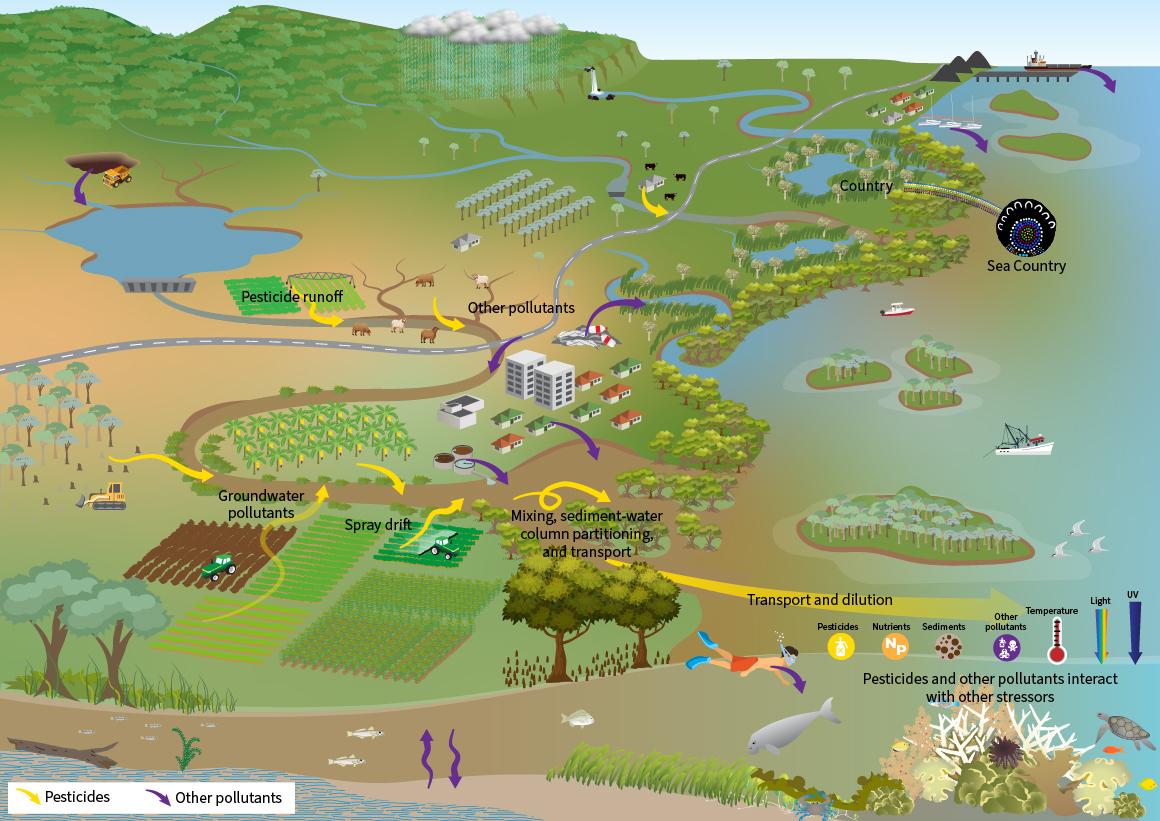
Context
Pesticides are used to protect crops and vegetated areas from pest organisms (e.g., weeds, insects and fungal disease). Pesticides have been detected in sediments and waters of rivers, creeks, wetlands, estuaries, and the inshore parts of the Great Barrier Reef. The types and concentrations of pesticides in fresh, estuarine and marine ecosystems vary between catchments and regions, reflecting the main land uses in each area. Pesticides have been reported to affect a range of marine organisms including corals, microalgae, crustose coralline algae and seagrass, with increasing evidence of their impacts on freshwater, wetland and estuarine ecosystems. The Reef 2050 Water Quality Improvement Plan pesticide target is to protect at least 99% of aquatic species at end-of-catchments by 2025. Other pollutants that may affect the Great Barrier Reef and are covered in the 2022 Scientific Consensus Statement include metals, plastics, persistent organic pollutants, per- and poly-fluoroalkyl substances, personal health care products, coal, and sunscreens.
The synthesis of the evidence for pesticides included a total of 591 studies extracted and synthesised for 3 questions. The pesticide questions review the evidence of the causal relationships between the risk, impacts and management of pesticides influencing the Great Barrier Reef starting by assessing the spatial and temporal distributions of pesticides within the Great Barrier Reef, their potential effects on local species and ecological risks to the freshwater and marine ecosystems (Q5.1), followed by the delivery processes and sources of pesticides found in Great Barrier Reef ecosystems (Q5.2). Synthesis of the most effective management practices for reducing pesticide risk in Great Barrier Reef ecosystems provides insights for policy and management (Q5.3). Other pollutants included 92 studies extracted and synthesised for 1 question that covers the spatial and temporal distribution, risk, and primary sources of other pollutants in Great Barrier Reef ecosystems (Q6.1).
Summary statement for Pesticides and other pollutants
The synthesis of the evidence for pesticides included a total of 591 studies extracted and synthesised for 3 questions (with some overlap in evidence between questions). Other pollutants included 92 studies extracted and synthesised for 1 question. The Summary Statement was developed using the evidence base from the four questions in this theme. Convergence was reached for this Summary Statement among all authors within the Expert Group for this theme.
The summary of findings relevant to policy or management action for pesticides and other pollutants are:
- Pesticides are ubiquitous across monitored Great Barrier Reef ecosystems including end-of-catchment waterways, palustrine wetlands (e.g., vegetated swamps) and in estuarine and nearshore marine habitats. Their presence in the offshore marine environment is largely unknown. Concentrations of pesticides (invariably as mixtures) are greatest in wetlands, followed by end-of-catchment then marine locations, with concentrations decreasing with greater distance from the site of application. Exposure of marine ecosystems to pesticides is closely linked to flood plume dispersal. Modelling suggests that pesticide exposure is highly dynamic, changing by orders of magnitude within hours. [Q5.1]
- Sites in the Mackay Whitsunday region, along with Barratta Creek in the Burdekin region, that feature intense cropping and lower discharge (related to rainfall), consistently record higher concentrations of pesticides and higher risk than other locations. [Q5.1]
- Annual trends in pesticide concentrations are difficult to identify over the short term; however, a long-term analysis indicated that photosystem II herbicide concentrations increased in some inshore sites of the Great Barrier Reef. [Q5.1]
- Pesticides are designed to control agricultural pest species and virtually all tested pesticides are potentially harmful to non-target aquatic species of the Great Barrier Reef region. For example, photosystem II herbicides consistently impact all photosynthetic marine organisms of the Great Barrier Reef that have been tested, including corals and seagrass. Other simultaneous pressures, including heatwave conditions and variation in light were shown to increase the sensitivity of Great Barrier Reef species to pesticides, indicating that guideline values applied under some conditions in the field are likely to underestimate the risk to aquatic ecosystems. [Q5.1]
- Monitored pesticides that contribute most to risk in all Great Barrier Reef ecosystems examined include atrazine, diuron, imidacloprid and metolachlor. Photosystem II herbicides dominate the contribution to risk in many waterways; however, non-photosystem II pesticides make substantial contributions to risk at specific locations, and their influence appears to be increasing since 2016. [Q5.1, Q5.2]
- Sugarcane areas are the largest contributor to end-of-catchment pesticide concentrations, and are dominated by photosystem II herbicides. While pesticides are used over large areas of grazing lands, the relative ecological toxicity to aquatic organisms of the dominant pesticide, tebuthiuron, is low compared to other photosystem II herbicides. Other land uses including forestry, horticulture, banana growing, and urban areas can be large users of some pesticides, but their total area within the Great Barrier Reef catchment area is relatively low. Nonetheless, they can contribute to pesticide concentrations. Catchments with minimal agricultural activity, such as the Ross and Kolan basins, have the lowest photosystem II herbicide contributions. Imidacloprid is the most commonly detected insecticide in the Great Barrier Reef catchment area and is associated with banana, sugarcane and urban activities. [Q5.2]
- The key factors that influence export of pesticides to the Great Barrier Reef are pesticide application rates, the timing between pesticide application and rainfall (longer timeframes between application and significant rainfall/irrigation are associated with lower pesticide exports), irrigation regimes, and pesticide properties such as persistence. Other factors that can influence delivery of pesticides to the Great Barrier Reef include soil characteristics, pesticide formulations (more soluble pesticides are more vulnerable to dispersal), climatic conditions and particularly extreme weather events, and catchment characteristics. [Q5.2]
- Most pesticide exported to the Great Barrier Reef is via surface runoff. Pesticide export via groundwater may be a contributor in some basins, although this has only been measured in the Wet Tropics region and Lower Burdekin floodplain. [Q5.2]
- The most effective management practices for reducing pesticide risk from the Great Barrier Reef catchment area vary between land uses. Practices that demonstrably reduce pesticide risk from agricultural land uses include reducing the total amount of pesticide applied through lower application rates (within label recommendations), improving application methods, timing of application in relation to weather risk periods, switching to pesticide products with lower environmental risk and reducing soil erosion through retaining cover, controlled traffic and improved irrigation management for pesticides with greater soil sorption. These findings have remained relatively consistent through time, and across climatic regimes and farming systems of the Great Barrier Reef catchments. A range of non-chemical pesticide control measures (integrated pest management, cultural controls that modify the pest’s growing environment) hold considerable potential for reducing reliance on chemical control measures, but most are yet to be trialled in the Great Barrier Reef catchment area with respect to long-term pesticide use reductions, efficacy and economic outcomes. [Q5.3]
- In the assessment of cost-effectiveness of pesticide management in agricultural industries, economic returns remain variable. However, for sugarcane, progressing from traditional to industry standard herbicide management is generally profitable across sugarcane districts. The adoption of management practices can be driven by a range of factors including costs and is discussed in detail in the theme on human dimensions of water quality improvement. [Q5.3]
- For non-agricultural lands, pesticide management options largely rely on non-structural controls such as regulations, and improved wastewater treatment processes (e.g., membrane bioreactors, reverse osmosis). The emergence of significant pesticide resistance across multiple industries has started to cause considerable changes in pesticide use and other alternative pest control measures. [Q5.3]
- Other pollutants detected in the waters, sediments and biota of the Great Barrier Reef include metals, persistent organic pollutants, per- and poly-fluoroalkyl substances, plastics, pharmaceutical, veterinary, and personal health care products, coal and fly ash and sunscreens. Assessment of spatial patterns, temporal trends and ecological risks for ecosystems and individual biota is severely limited by data availability. There are very few routine monitoring programs for these pollutant groups, with the exception of some monitoring within the Regional Report Cards (e.g., Gladstone, Dry Tropics and Mackay Whitsunday) for which the raw data are not publicly available. [Q6.1]
- Metal concentrations in water and sediments are higher in more industrial and developed coastal environments compared to less developed catchments and offshore areas. Concentrations of metals in water above national water quality guideline values are rarely documented, but have been recorded in some studies including copper (associated with legacy mining in the Fitzroy basin), mercury (associated with sugarcane in the Tully catchment) and aluminium (from acid sulfate soils in Trinity Bay, Cairns). Biota found inshore (e.g., seagrass, algae, turtles, corals) have higher concentrations of metals in their tissues than those found offshore. Although ecotoxicological studies indicate that the ecological risks from metals in the Great Barrier Reef are relatively low and constrained to a few small locations, the combined risks from mixtures have not been assessed. [Q6.1]
- Persistent organic pollutants are associated with industry, oil spills, coal, and urbanisation. They are detectable in Great Barrier Reef sediments (generally below guidelines values, with exceptions such as following oil spills) and biota, and from the limited data available, decrease across an inshore to offshore gradient. Persistent organic pollutants can affect fish physiology and behaviour, coral reproduction and trophic food webs. [Q6.1]
- Plastics, including microplastics and fibres, are extensively distributed in coastal and marine environments. Coastal sites are influenced by surrounding land use, river and stormwater inputs, while offshore sites are mostly influenced by recreational activities, tourism, commercial shipping and fishing. Plastics have been recorded in zooplankton, crustaceans, fishes, birds and turtles from the Great Barrier Reef, with ecological risks varying across species, feeding behaviour and life stages. [Q6.1]
- A more cohesive and coordinated approach to examine the interaction of multiple pollutants and stressors, including climate change, is required. Ecotoxicological studies that employ multiple lines of evidence are urgently required for all pollutant groups identified in the Great Barrier Reef to understand the risks that these pollutants pose to Great Barrier Reef biota and ecosystems. [Q6.1]
Confidence
The confidence rating of the questions in this theme was Moderate to High for the pesticide questions, and Limited to Moderate for the other pollutants question, due to the limited evidence available for most of the other pollutant groups.
Strength of evidence
The findings in this theme are underpinned by a growing body of evidence (although larger for pesticides than for other pollutants), including multiple lines of evidence (i.e., monitoring, modelling, observations, remote sensing, experimental, and secondary studies). The strength of evidence across this theme considering the confidence, quantity and diversity of study types, is High for pesticides, and Low for other pollutants, with limited evidence for per- and poly-fluoroalkyl substances, pharmaceutical, veterinary, and personal health care products, coal and fly ash, and sunscreens.
Key uncertainties
The key uncertainties of the evidence identified for pesticides and other pollutants relevant to policy and management included the spatial distribution of pesticides in some ecosystems of the Great Barrier Reef, such as some freshwater and inshore marine ecosystems and most wetland, estuarine and offshore ecosystems; limited temporal pesticide data overall, which restricts the capacity to determine if changes to pesticide management are improving water quality outcomes; limited understanding of the toxicity of many alternative pesticides detected in Great Barrier Reef waterways; the proportion of pesticides contributed by groundwater in different catchments of the Great Barrier Reef; standardised assessment methods for cost-effectiveness of improved pesticide management across different agricultural land uses; the effectiveness of stormwater treatment measures such as wetlands; and distribution, sources and ecological risks of some of the ‘other pollutant’ groups including many metals, persistent organic pollutants, per- and poly-fluoroalkyl substances, pharmaceutical, veterinary, and personal health care products, coal and fly ash, and sunscreens.
Recent findings
Recent findings continue to identify the spatial and temporal distribution of pesticides on Great Barrier Reef ecosystems, including a prominent modelling exercise that simulated the distribution of the photosystem II herbicide diuron in the Great Barrier Reef. In terms of impacts, additional field and laboratory research has focused on the toxicity of pesticides to Great Barrier Reef species, including the combined effects of pesticide mixtures, as well as other simultaneous pressures such as heatwave conditions. Recent studies have strengthened previous evidence of the link between photosystem II herbicides and agricultural activities, particularly sugarcane, and highlighted the relationship between timing of pesticide application and timing of localised rainfall (first flush) with runoff risk. Emerging findings also include greater recognition of pesticide risk in management frameworks, allowing management practices to be better targeted to manage specific risks, renewed focus on Integrated Pest Management concepts and increasing acknowledgement of variable water quality benefits from tillage-crop residue retention practices. Several ‘alternative’ pre-emergent herbicides (metribuzin, metolachlor, etc.) have been recently identified that present similar ecosystem risk profiles to at least some of the priority photosystem II herbicides such as atrazine. In relation to ‘other pollutants’, recent research included an extensive per- and poly-fluoroalkyl substances sampling program, studies on the distribution of plastics and their effects on selected biota, experimental research on the effects of coal on corals, and some advances in ecotoxicological tools for assessing the effects of pollutants on turtles.
Knowledge gaps
For pesticides and other pollutants, the areas where further knowledge is needed that are most relevant to policy and management include:
- Experimental studies on the effects of pesticides mixtures and in combination with other co-stressors on Great Barrier Reef species and the implications for water quality guidelines.
- Further model developments to improve the ability to estimate pesticide risk, such as expanding the model to include all pesticides identified in the Great Barrier Reef, and additional in situ field validation using observations of pesticide concentrations from the Great Barrier Reef Catchment Loads Monitoring Program and the Marine Monitoring Program.
- Time lags and pesticide migration in groundwater.
- The contribution of particle bound pesticides to off-site migration, and the drivers of transport to better characterise ecological risk to receiving ecosystems.
- The properties, persistence, delivery pathways and ecological toxicity of the newer emerging alternative pesticides such as imazapic and fluroxypyr.
- The efficacy and economic outcomes of non-chemical pesticide control measures.
- Additional data to assess the management effectiveness of many insecticides and fungicides in farming systems, including usage patterns, current presence in the environment, half-lives, sorption, runoff potential and ecotoxicology.
- Assessment of the chemical risk of wastewater re-use where tertiary treatment is not occurring.
- Fundamental exposure data and establishment of water and sediment guidelines values for pesticides and their degradation products and for most of the ’other pollutant’ groups including coal, per- and poly-fluoroalkyl substances, pharmaceutical, veterinary, and personal health care products and sunscreens.
- Establishment of sediment guideline values for some metals (e.g., manganese, aluminium, arsenic), and refinement of water guideline values to include tropical species.
- The interactions of multiple pollutants and stressors, including climate change.
Summary information for Pesticides and other pollutants
The table below summarises the evidence appraisal indicators and confidence ratings in the evidence base for each of the Questions in this theme. The Confidence rating was determined by the overall relevance of studies to the question and the consistency of the body of evidence (see the Glossary for an explanation of the indicators). Note: In Diversity of items: Experimental (E), Mixed (X), Modelling or Remote sensing (M), Observational (O), Reviews (R), Theoretical or Conceptual (T).
| Question | Quantity of items | Diversity of items | Overall Relevance | Consistency | Confidence |
| What is the spatial and temporal distribution of pesticides across Great Barrier Reef ecosystems, what are the (potential or observed) ecological impacts in these ecosystems and what evidence is there for pesticide risk? [Q5.1] | High (231) |
High (45% E, 29% O, 18% X, 8% R) |
High | High | High |
| What are the primary sources of the pesticides that have been found in Great Barrier Reef ecosystems and what are the key factors that influence pesticide delivery from source to ecosystems? [Q5.2] | High (109) |
High (31% O, 29% E, 23% R, 17% M-X) |
High | Moderate-High | Moderate-High |
| What are the most effective management practices for reducing pesticide risk (all land uses) from the Great Barrier Reef catchments, and do these vary spatially or in different climatic conditions? What are the costs of the practices, and cost-effectiveness of these practices, and does this vary spatially or in different climatic conditions? What are the production outcomes of these practices? [Q5.3] | High (251) |
High (36% E, 32% O-R, 32% X) |
Moderate | Moderate | Moderate |
| What is the spatial and temporal distribution and risk of other pollutants in Great Barrier Reef ecosystems, and what are the primary sources? [Q6.1] | Low-Moderate (92) (44 metals; 19 POPs; 1 PFAS; 19 plastics; 4 PVPs; 5 Coal) |
Low-High (depending on pollutant) (77% O, 23% E) |
Low – High (depending on pollutant) |
Low-High (depending on pollutant) |
Limited-Moderate (Moderate for Metals, POPs and Plastics; Limited for PFAS, PVPs, Coal and Sunscreen) |
